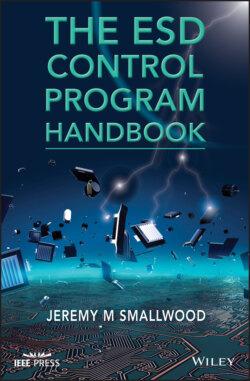Читать книгу The ESD Control Program Handbook - Jeremy M. Smallwood - Страница 18
1.2 Charge, Electrostatic Fields, and Voltage 1.2.1 Charge
ОглавлениеThe charge is a property of elementary particles – electrons and protons – that make up the atoms of all materials. All materials are made up of positively charged atomic nuclei and negative electrons (Cross 1987). The charge on a proton in the nucleus is labeled positive, and the charge on an electron is labeled negative. The charge effects of a proton are equal and opposite to those of an electron, so if a proton and electron are together in an atom, their effects cancel exactly. In this case, the atom is neutral. Atoms of different elements have many protons and electrons, depending on the particular element. For example, a hydrogen atom has 1 proton and 1 electron, and a carbon atom has 12 protons in the nucleus and 12 electrons surrounding it. An object or material is made of huge numbers of atoms and so extraordinary numbers of electrical charges.
When talking of static electricity, it is often said that charge is “generated” in certain circumstances. That is not so – all that happens is that a small number of negative charges become separated from their positive companions in a material and end up in a different place. For every negative charge appearing somewhere, there must be a positive charge appearing somewhere else. An object is described as charged if it has a net imbalance of the number of positive and negative charges that it contains. The electrical effects of the charges are no longer balanced, and a net static electrical charge exists at that location. It is this net charge imbalance that we are referring to when we talk about the charge on an object or material.
The unit of charge is the coulomb (C). In practice, the coulomb is a rather large amount of charge and microcoulombs (μC, 10−6C), nanocoulomb (nC, 10−9C), or even picocoulombs (pC, 10−12C) are more usual. A single electron or proton has a charge of 1.6 × 10−19C. So, an object having even 1nC of net charge has a large number, 6.2 × 109, of unneutralized electrons or protons.
